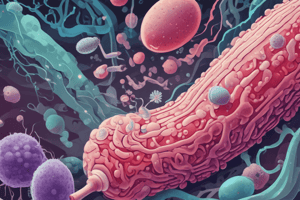Podcast
Questions and Answers
How do tetracyclines achieve selective toxicity towards bacteria?
How do tetracyclines achieve selective toxicity towards bacteria?
- By entering mammalian cells with lower affinities
- By requiring magnesium ions for their binding at the ribosomal site
- By preventing aminoacyl tRNA binding to the mRNA-ribosome complex
- By concentrating within bacterial cells due to an active uptake process (correct)
What is the mechanism behind ribosomal protection in bacteria against tetracyclines?
What is the mechanism behind ribosomal protection in bacteria against tetracyclines?
- Increasing the bacterial cell self-destructive capacity
- Reducing intracellular tetracycline concentration
- Inhibiting enzymatic oxidation
- Rendering the bacterial protein synthesis apparatus resistant (correct)
Why do tetracyclines have selective toxicity towards bacteria?
Why do tetracyclines have selective toxicity towards bacteria?
- Because bacterial cells concentrate tetracyclines internally (correct)
- As a result of passive diffusion into bacterial cells
- Due to higher affinities for mammalian ribosomes
- Because of their inhibitory effect on enzymatic oxidation
What is the role of magnesium ions in the mechanism of action of tetracyclines?
What is the role of magnesium ions in the mechanism of action of tetracyclines?
How do tetracyclines enter bacterial cells?
How do tetracyclines enter bacterial cells?
What is a key characteristic of the mechanism of action of macrolides?
What is a key characteristic of the mechanism of action of macrolides?
What is the mechanism of action of macrolide antibiotics like erythromycin, clarithromycin, and azithromycin?
What is the mechanism of action of macrolide antibiotics like erythromycin, clarithromycin, and azithromycin?
What structural feature of macrolide antibiotics contributes to their acid stability?
What structural feature of macrolide antibiotics contributes to their acid stability?
Which of the following is a key structural modification that was made to macrolide antibiotics to improve their pharmacokinetics and pharmacodynamics?
Which of the following is a key structural modification that was made to macrolide antibiotics to improve their pharmacokinetics and pharmacodynamics?
Which of the following is a key advantage of azithromycin over erythromycin?
Which of the following is a key advantage of azithromycin over erythromycin?
What is a key advantage of clarithromycin over erythromycin?
What is a key advantage of clarithromycin over erythromycin?
What is a key structural feature of macrolide antibiotics that helps overcome erythromycin resistance?
What is a key structural feature of macrolide antibiotics that helps overcome erythromycin resistance?
Which of the following statements accurately describes the mechanism of action of protein synthesis inhibitors?
Which of the following statements accurately describes the mechanism of action of protein synthesis inhibitors?
Which of the following statements accurately describes the selectivity of aminoglycoside antibiotics?
Which of the following statements accurately describes the selectivity of aminoglycoside antibiotics?
Which of the following aminoglycoside antibiotics is primarily used in the treatment of tuberculosis?
Which of the following aminoglycoside antibiotics is primarily used in the treatment of tuberculosis?
Which structural feature of aminoglycosides is particularly important for their antibacterial activity?
Which structural feature of aminoglycosides is particularly important for their antibacterial activity?
Which of the following statements accurately describes the structure-activity relationship (SAR) of aminoglycosides?
Which of the following statements accurately describes the structure-activity relationship (SAR) of aminoglycosides?
Which of the following classes of antibiotics also inhibits protein synthesis by binding to ribosomes?
Which of the following classes of antibiotics also inhibits protein synthesis by binding to ribosomes?




